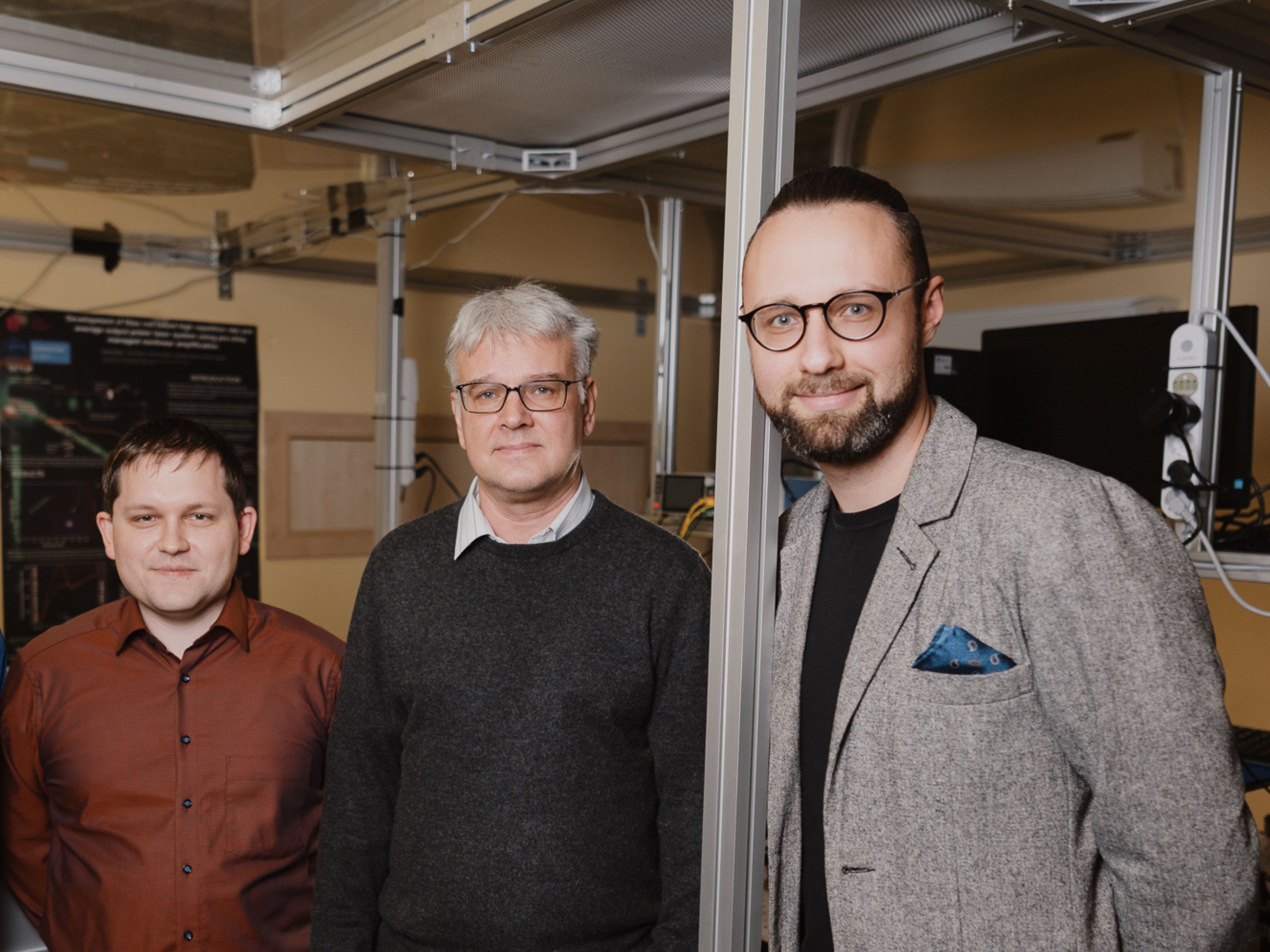Scientists from the Laser Research Center (LRC) at the Faculty of Physics of Vilnius University (VU) together with an international team of experts, have developed a unique parametric light generator – a source of laser radiation. Their research has been published in the prestigious journal ‘APL Photonics’.
This device converts a pump wave in a nonlinear medium into two waves whose photon energy equals that of the initial radiation, and whose frequencies can be tuned. The researchers are pleased to have achieved extremely high spectral purity of the laser radiation, excellent beam quality, and nearly ideal temporal characteristics – something they note had previously been difficult to accomplish.
 Dr Julius Vengelis, Dr Vygandas Jarutis, PhD student Jonas Banys. Photo by Ugnius Bagdonavičius.
Dr Julius Vengelis, Dr Vygandas Jarutis, PhD student Jonas Banys. Photo by Ugnius Bagdonavičius.
‘The new device, based on the combination of a microlaser generating subnanosecond (300 ps–1 ns) pulses and a periodically poled nonlinear crystal with a submicrometer (<1 µm) grating period, enabled the realization of laser radiation with exceptionally high spectral, spatial, and temporal quality. Unique light, both forward and backward,’ explain the VU physicists.
‘Such a laser radiation source can be used in quite specific scientific research, for example in kinetic spectroscopy to excite and study ultrafast processes in molecules, where a very narrow spectral bandwidth is needed, and subnanosecond pulse durations are sufficient to observe molecular responses,’ explained VU physicist Dr Julius Vengelis.
Although this pulse duration is not the shortest achievable by lasers, it is sufficient to observe many ultrafast processes.
According to Dr Vengelis, if light travels around the Earth seven and a half times in one second, then in 500 picoseconds it only travels about 15 cm – the length of a sheet of paper. That is a very short moment.
‘The first backward wave optical parametric oscillator (BWOPO) pumped by subnanosecond pulses from a Nd:YAG microlaser was created using a unique Rb-doped periodically poled KTP (Rb:PPKTP) crystal, with a grating period of only 427 nm,’ explained Dr Vengelis.
‘We are delighted that our colleagues abroad succeeded in fabricating such a unique crystal, and that we were able to use our experience in nonlinear optics to realize this device,’ added the VU physicists.
The study was carried out by LRC scientists PhD student Jonas Banys, Dr Vygandas Jarutis, and Dr Julius Vengelis, along with Lithuanian researchers abroad Dr Jonas Jakučis Neto (Department of Aerospace Science and Technology, Brazil), Dr Andrius Žukauskas, and Prof. Valdas Pašiškevičius (Royal Institute of Technology, Sweden).
‘The developed tunable wavelength laser radiation source was characterized during the study, and it was demonstrated how the application of counter-propagating three-wave interaction enables the generation of nearly transform- and diffraction-limited tunable laser radiation in such a device with 50% conversion efficiency. The unique operational features of this device in the degenerate regime were also analyzed,’ explained the authors.
In other words, the researchers measured the spectra of the generated light, pulse durations, and assessed beam quality, as well as how all these parameters vary with changes in wavelength.
According to the physicists, microlaser-pumped subnanosecond pulse duration optical parametric generators hold significant potential. These devices are compact, have a simple construction, and provide a cost-effective source of tunable wavelength laser radiation.
‘They are especially useful in applications where high temporal resolution is not required. Instead of using several lasers generating subnanosecond radiation at different wavelengths, we can use just this single parametric light generator,’ say the LRC colleagues. They continue to pursue related scientific research and are further developing this laser radiation source.
It is hoped that the study will contribute to the development of more efficient tunable wavelength laser radiation with higher output quality, based on subnanosecond pulse-duration microlasers.
The research was conducted under the ‘Universities’ Excellence Initiative’ program. The project is funded by the Research Council of Lithuania and the Ministry of Education, Science and Sport of the Republic of Lithuania (Project No. S-A-UEI-23-6).
